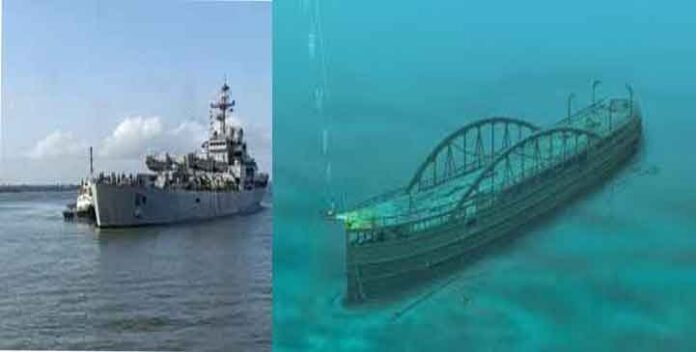Discover the astonishing wreckage of a 170-year-old ship near Öland, Sweden. This 19th-century vessel, loaded with champagne bottles, mineral water, and porcelain, offers a glimpse into history. Polish diver Stachura’s remarkable find reveals a well-preserved underwater treasure.
INVC NEWS
Oland : In a stunning revelation that has history enthusiasts and treasure hunters buzzing, the wreckage of a 170-year-old ship has been found near Öland, Sweden. This ship, which sank in the 19th century, was discovered 37 kilometers south of Öland. Among its cargo were champagne bottles, mineral water, and porcelain ceramics, all remarkably well-preserved. The Polish diver, Tomasz Stachura, who unearthed this underwater time capsule, has spent the last 40 years photographing shipwrecks in the Baltic Sea. However, this discovery, featuring over 100 bottles of wine, is unlike anything he has encountered before. Let’s dive into this fascinating story of maritime history, adventure, and the allure of sunken treasures.
The Discovery: A Maritime Mystery Unveiled
Uncovering the Past
The Baltic Sea, with its cold, brackish waters, is known for preserving shipwrecks remarkably well. The wreckage of the 170-year-old ship found near Öland is a testament to this phenomenon. Stachura’s discovery came as a pleasant surprise during one of his many explorations in these historic waters.
- Location: 37 kilometers south of Öland, Sweden
- Cargo: Champagne bottles, mineral water, porcelain (ceramic)
- Condition: Excellent preservation due to Baltic Sea conditions
The Moment of Discovery
Imagine the thrill of finding a shipwreck that has been resting undisturbed for nearly two centuries! Stachura, whose passion for underwater photography has led him to countless shipwrecks, describes this find as particularly unique. “I’ve seen many wrecks in my career, but this is the first time I’ve come across more than 100 bottles of wine on a single ship,” he said in a press release issued by his company.
The Ship’s Last Voyage
The ill-fated ship, now lying 37 kilometers south of Öland, embarked on its final journey over 170 years ago. Its cargo, a fascinating mix of luxury and necessity, offers a peek into the past and the maritime trade of the era. The champagne bottles, mineral water, and porcelain were likely intended for affluent clientele, reflecting the tastes and commerce of the time.
The Treasure: Champagne, Mineral Water, and Porcelain
Champagne: A Luxurious Find
The discovery of champagne bottles in the wreckage is perhaps the most intriguing aspect. Champagne, synonymous with celebration and luxury, would have been a prized cargo. Over 100 bottles were found, and their condition could provide insights into 19th-century production and storage methods.
- Number of Bottles: Over 100
- Condition: Preserved well enough to potentially still contain liquid
Mineral Water: A Curious Cargo
The inclusion of mineral water among the ship’s cargo raises questions about its intended use. Was it for health, luxury, or simply a staple for the voyage? These bottles offer a window into the daily lives and preferences of those aboard.
Porcelain: Durable Beauty
Porcelain, renowned for its beauty and durability, was a significant part of the cargo. The ceramics found in the wreckage are likely to be in remarkable condition, providing a tangible connection to the artisans and traders of the 19th century.
The Discoverer: Tomasz Stachura
A Lifetime Underwater
Tomasz Stachura is no stranger to the mysteries of the deep. With 40 years of experience in photographing shipwrecks in the Baltic Sea, his expertise and dedication are unmatched. Stachura’s passion for uncovering and documenting maritime history has led to this extraordinary discovery.
A Career Highlight
In a press release, Stachura’s company highlighted the significance of this find, noting the exceptional condition of the wreckage and its cargo. This discovery not only adds to Stachura’s impressive portfolio but also to the collective maritime history of the Baltic Sea region.
The Significance: Why This Discovery Matters
Historical Insights
The wreckage of the 170-year-old ship found near Öland provides invaluable historical insights. The preserved cargo can shed light on trade routes, economic conditions, and daily life in the 19th century.
Archaeological Importance
This discovery is a boon for maritime archaeologists. The well-preserved state of the ship and its contents offers a rare opportunity to study and understand the construction, materials, and cargo of the era.
Cultural Fascination
Beyond its scientific value, this discovery captivates the imagination. Tales of sunken treasures and underwater mysteries have always fascinated people, and this find adds a tangible chapter to those stories.
FAQs
What is the significance of the champagne bottles found in the wreckage?
The champagne bottles are significant because they offer a glimpse into the luxury goods traded and consumed during the 19th century. Their preservation also provides an opportunity to study historical production and storage methods.
How was the wreckage so well-preserved?
The cold, brackish waters of the Baltic Sea are known for preserving shipwrecks exceptionally well. The low salinity and temperatures slow down the degradation process, keeping the wreckage in good condition.
Who discovered the wreckage?
The wreckage was discovered by Polish diver Tomasz Stachura, who has been photographing shipwrecks in the Baltic Sea for the past 40 years.
What can we learn from this discovery?
This discovery can provide insights into 19th-century maritime trade, economic conditions, and daily life. It also offers a rare opportunity to study well-preserved historical artifacts.
The wreckage of the 170-year-old ship found near Öland is a remarkable discovery that offers a unique glimpse into the past. The champagne bottles, mineral water, and porcelain ceramics found aboard paint a vivid picture of 19th-century maritime trade and luxury. Thanks to the dedication of diver Tomasz Stachura, this underwater treasure has been brought to light, providing invaluable historical and archaeological insights. As researchers and historians continue to study the wreckage, we can look forward to uncovering even more secrets from this sunken time capsule.
















